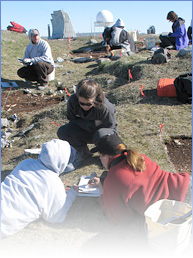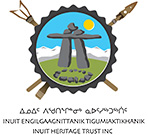| Projects: Archaelogical Field Schools | |
|
IHT is revising its field school project and will most likely implement a new, similar program in 2014. 2015 - Seal River Heritage Lodge / Hubbard Point After several years of absence IHT together with Ocean's North did conduct an archaeology excavation and field school at a Thule site in Northern Manitoba. Originally it was planned to work at the Hubbard Point site about 60km north of Seal River Heritage Lodge. Due to difficult weather and sea conditions we chose an alternative site in walking distance from the lodge. Since both Hubbard Point and the alternative sites are situated near the border to Nunavut in lands that were traditionally used by Dene and Inuit alike the field school brought together an archaeologist (Virginia Petch), elders and students from both cultures, Dene from Tadoule Lake and Inuit from Arviat, Rankin Inlet and Igloolik. The site turned out to be very exciting since the participants could identify over 130 visible features of Inuit habitation at the Seal River Lodge site (qajaq stands, tent rings, sod houses, grave sites) and they excavated close to 300 artefacts (mostly bones but also a few tools and tool pieces). Of particular importance were the knowledge and the stories of the elders who never got tired to share their wisdom with the students, the archaeologist and the rest of the team. The staff of Seal River Lodge made our stay very comfortable, prepared wonderful meals and their guides kept us great company and save from polar bears. It is intended to continue archaeological field work and the field school at Seal River Lodge and Hubbard Point in the upcoming years. Beneficiaries who are interested in participating in a 1-2 week archaeology exercise are encouraged to send a short expression of interest to the IHT program manager Torsten Diesel (tdiesel@ihti.ca, 867-979-0731). The program manager will contact potential participants in advance to discuss the terms and conditions of the next available field school. Because of other staffing commitments, there will be no field school this summer. IHT and GN-CLEY will be taking a summer off to conduct a thorough evaluation of the program to ensure our goals are being met and to determine the best model to foster archaeological training in Nunavut. 2006, 2007, 2008 - Hall Beach, Watamaniuk site IHT and the Government of Nunavut (Department of Culture, Language, Elders and Youth) partnered together in order to offer a joint field school. During this time, we focused on one community to offer an ongoing field school where each student acted as an archaeological assistant. While they were assisting Julie Ross, the Territorial Archaeologist to try and answer some questions she had about the Hall Beach Thule site, they were also learning many new skills. Six days each week, students would be brought to the site and then walk in a short way to the site where we were actually working to avoid interference with DEW Line site clean-up activities. During the day they would excavate certain areas of this large site, take electronic readings of topography and archaeological features to create electronic maps, take photos of stratigraphy, artifacts and features as well as help out with maintaining the integrity of the day camp (clean the porta-potty, get water, help cooking, clean up, etc…). As well, at the end of each day they would have time to personally reflect upon the work they did that day by writing in their journals. Fortunately we had much better weather this year than last and didn’t have any bad weather days where we stayed in town rather than go to the site. They had the opportunity to learn about other aspects of archaeology, cleaned the artifacts, learned about zooarchaeology, gender and archaeology and about Arctic archaeology in particular. They were also responsible to prepare an exhibit at the end of their work to present to the community of Hall Beach. Throughout the whole project they were expected to be ambassadors of their community and be respectful of the people of Hall Beach. 2005 - Pond Inlet, Qilalukan site During this field school, each student acted as an archaeological assistant. While they were assisting the head and assistant archaeologist to try and answer some questions she had about the Qilalukan site they were also learning many new skills. Each weekday the students would be brought to the site and then walk in a short way to the site where we were actually working because the road was too muddy for the truck. During the day they would excavate certain areas of this large site, take electronic readings of topography and archaeological features to create electronic maps, take photos of stratigraphy, artifacts and features as well as help out with maintaining the integrity of the day camp (change the honey bucket, get water, help cooking, clean up, etc…). As well, at the end of each day they would have time to personally reflect upon the work they did that day by writing in their journals. During rainy days they stayed in town and learnt about other aspects of archaeology, cleaned the artifacts and about Arctic archaeology in particular. They were also responsible to prepare an exhibit at the end of their work to present to the community of Pond Inlet. Throughout the whole project they were expected to be ambassadors of their community and be respectful of the people of Pond Inlet. 2004 - Naujaat / Repulse Bay, Naujaat Site In 2004, IHT partnered with Dr. Sue Rowley and the University of British Columbia to learn more about the Naujaat site. It had been partially excavated by Matthiason as part of the Fifth Thule Exhibition in the early 1920s. Students learnt a range of archaeological skills that could enable them to gain employment within the archaeological field as assistants to archaeologists. Though it takes many years of post-secondary education to become a certified archaeologist, their exposure and continued access to archaeological projects will enable them to become local experts of their own communities archaeology and heritage. They learnt about archaeology as a career, the theory and methods behind it, the fine motor skills required, the framework in which to conduct an investigation and how to respect their heritage by conducting an archaeological enquiry/excavation in a sound way. 2003 - Kugluktuk, Tree River Area In the summer of 2003, a few students and their families participated in an informal field survey in the Tree River area, not far from Kugluktuk. Many Kugluktuk Elders grew up in this area and the area is known to contain many archaeological sites. One of the aims of the survey was to identify and document these sites for their protection. 2002 - Kugluktuk, Roman Catholic Church An Archaeology Field School was held in Kugluktuk during August of 2002. In 2002, eight Nunavut students joined archaeologist Ken Swayze for the dig. Applications for student participation were solicited from all over Nunavut and included students from all three regions of Nunavut (Kitikmeot, Kivalliq and Baffin). The students were introduced to archaeology on a site in Kugluktuk next to the Roman Catholic Church. Artifacts including a copper point on a wooden shaft and a muskox horn ladle had been found on this site previously. |
IHT knows the value of education and hands-on experience in encouraging youth to enter a career in heritage.
 |
